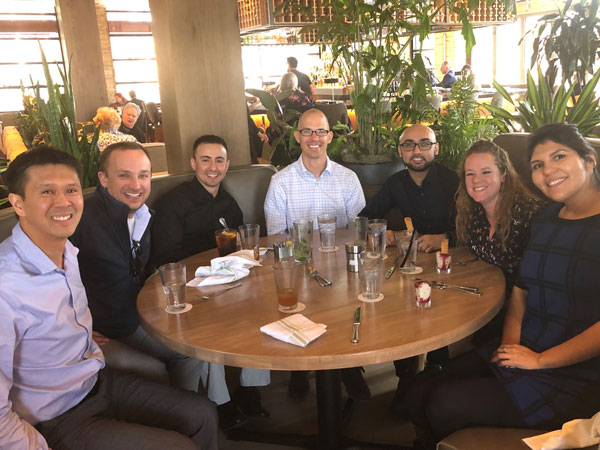Thirty Sandia employees, working in departments ranging from engineering to security, recently finished a deep dive into leadership skills through the Future Leaders Pathway program. The seven-month pilot program provided an opportunity for partnership building across the Labs, identifying professional strengths through classroom activities, group projects and self-reflection about career goals and personal motivations.
“I thought about the term leader in a broader context after this program,” said Rachael Gutierrez, in partnership and planning in facilities at Sandia/California. “I learned about how my skills could benefit other groups across the Labs.”
Starting in July 2018, 25 employees from Sandia/New Mexico and five from Sandia/California met in Albuquerque every other month for courses about leadership, teamwork, networking, strengthening personal resiliency and bringing visions to fruition. The classes were taught by Sandia leaders, an Olympic pentathlete, and business professors from Case Western Reserve University, the University of Texas, Austin, and the University of California, Los Angeles.
“The goal of the program was to build leaders who could competently and confidently step into leadership roles, whether formally or informally.”
Some meetings also involved small-group sessions with senior leaders and managers. “Those sessions were valuable because they allowed us to ask questions that we wouldn’t have the opportunity to otherwise,” Rachael said.
Janice Duis, a leadership and organizational development specialist at the Labs, and a team of volunteers from across the Labs helped craft the content based on feedback from focus groups and the needs assessment of early-career employees. “The goal of the program was to build leaders who could competently and confidently step into leadership roles, whether formally or informally,” Janice said.
The group divided into four teams, each sponsored by an associate Labs director, to explore issues such as attraction and retention, onboarding, recognition and program improvement. Each team selected a topic and created a presentation to senior leadership. Then team members made recommendations based on their perspective from working less than five years at the Labs.

Several participants agreed that one of the most valuable parts of the program was working with colleagues from diverse professional and academic backgrounds. Those connections helped them expand their networks to departments and divisions where they did not have previous connections. Following the lesson to maintain their networks, Rachael said her team plans to stay in touch and reconnect every few months.
The program also provided time for self-reflection that would have been hard to find in a standard work day. Before the program, Steve Hau, a business development specialist at Sandia/California, wondered if his easygoing management style would be compatible with effective leadership. “This program allowed me to see that leadership could be a path for me with that personality trait,” he said.
Since the program ended in February, Justin Martinez and several other participants have been promoted, and he said the program helped him prepare for his new role. “I’ve immediately applied the many lessons I learned.” Of the several leadership courses he has taken at Sandia, Justin said, “This one, by far, is the best.”
Janice recommends that individuals with an interest in leadership development start by talking with their managers.